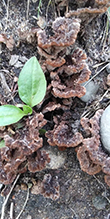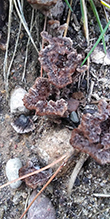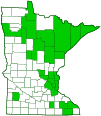Earthfan
(Thelephora terrestris)
Conservation • Description • Habitat • Ecology • Distribution • Taxonomy
Conservation Status |
|
|||||||
| IUCN Red List | not listed |
|||||||
| NatureServe | NNR - Unranked |
|||||||
| Minnesota | not listed |
|||||||
Description |
||
Earthfan is a strange looking and inconspicuous but common fungus. It occurs on every continent worldwide except Antarctica, but it is almost completely absent between the latitudes of 30° north and 30° south. In the United States, it occurs east and west of the Great Plains, but it is absent from the Great Plains, where there are few woodlands, its natural habitat. It is common in Minnesota. It is often overlooked because the dark brown fruiting body blends in well with the plant litter on the forest floor. Earthfan is found in summer and fall in coniferous, deciduous, and mixed forests, and pine plantations. It grows on the ground under pine, alder, birch, oak, beech, and poplar. It usually appears in clusters, but it may also be grouped or solitary. It has a mutually beneficial relationship (mycorrhizal) with the tiny rootlets of trees, absorbing sugars and amino acids while helping the tree absorb water. It is sometimes found lightly attached to rotting wood, suggesting that it may also get nutrients from dead or decaying wood (saprobic). Earthfan is common in potted plants in nurseries. It is very common in nurseries that grow conifer seedlings for use in reforestation projects. The fruiting body is a 2⅜″ to 6″ (6 to 15 cm) in diameter rosette or cluster of one to several cap-like structures. The cap, sometimes referred to as the petal, is fan shaped to semi-circular, depressed in the center, and ¾″ to 2⅜″ (2 to 6 mm) long and wide. The color is various dark shades of brown, reddish brown, chocolate brown, or grayish brown. Occasionally it is zoned, sometimes with just a single dark band in the middle. The surface is dry and wrinkled radially. It is radially covered with short and velvety or longer and silky fibers. The margin is smooth at first, soon becoming split. It is usually also fringed. On freshly growing petals the margin is whitish. The underside is grayish brown, clay brown, medium brown, or reddish brown. It is wrinkled and smooth, not covered with fibers. On older specimens, it is covered with elongated bumps that are more or less radially arranged. There are no pores on the underside. The stalk, if present, is short, thin, tough, and the same color as the cap but often paler. The flesh is thin and tough. It has a mild odor that is described as earthy. The edibility is unknown. The spore print is purplish brown. |
||
Similar Species |
||
Stinking Earthfan (Thelephora palmata) caps are branched, coral-like. It has a strong garlicky odor when young that becomes a strong unpleasant odor with age. It is far less common. |
||
Habitat and Hosts |
||
Coniferous, deciduous, and mixed forests, pine plantations |
||
Ecology |
||
Season |
||
Summer and fall |
||
Distribution |
||||
|
Sources |
|||
| 11/26/2023 | ||||
Occurrence |
||||
Common and widespread |
||||
Taxonomy |
|||
| Kingdom | Fungi (Fungi) | ||
| Subkingdom | Dikarya | ||
| Phylum | Basidiomycota (Basidiomycete Fungi) | ||
| Subphylum | Agaricomycotina (Higher Basidiomycetes) | ||
| Class | Agaricomycetes (Mushrooms, Bracket Fungi, Puffballs, and Allies) |
||
Order |
Thelephorales | ||
Family |
Thelephoraceae | ||
Genus |
Thelephora | ||
The Thelephora terrestris in North America, which grows under both pines and hardwoods, is probably not the same as the fungus with that name in Europe, which grows only under pines. A recent molecular DNA study of the genus Thelephora (Ramírez-López et al., 2015) suggests that Thelephora terrestris as currently defined may actually be a complex of several distinct species. |
|||
Synonyms |
|||
Coniophora eradians Hyphoderma terrestre Phylacteria terrestris Stereum laciniatum Thelephora crustosa Thelephora eradians Thelephora minor Thelephora rhipidium Thelephora tristis |
|||
Common Names |
|||
Common Fiber Vase Fiber Vase Earthfan Groundwart |
|||
Glossary
Mycorrhizal
A symbiotic, usually beneficial relationship between a fungus and the tiny rootlets of a plant, usually a tree.
Saprobic
A term often used for saprotrophic fungi. Referring to fungi that obtain their nutrients from decayed organic matter.
Visitor Photos |
|||||
Share your photo of this fungus. |
|||||
| This button not working for you? Simply email us at info@MinnesotaSeasons.com. Attach one or more photos and, if you like, a caption. |
|||||
Luciearl |
|||||
 |
 |
||||
MinnesotaSeasons.com Photos |
|||||
|
|||||

Visitor Videos |
|||
Share your video of this fungus. |
|||
| This button not working for you? Simply email us at info@MinnesotaSeasons.com. Attach a video, a YouTube link, or a cloud storage link. |
|||
Other Videos |
|||
| Chropiatka pospolita (Thelephora terrestris) Jaworzno 13.05.2017 Paweł i Grzyby |
|||
About
May 15, 2017 |
|||

Created: 11/27/2023
Last Updated:





